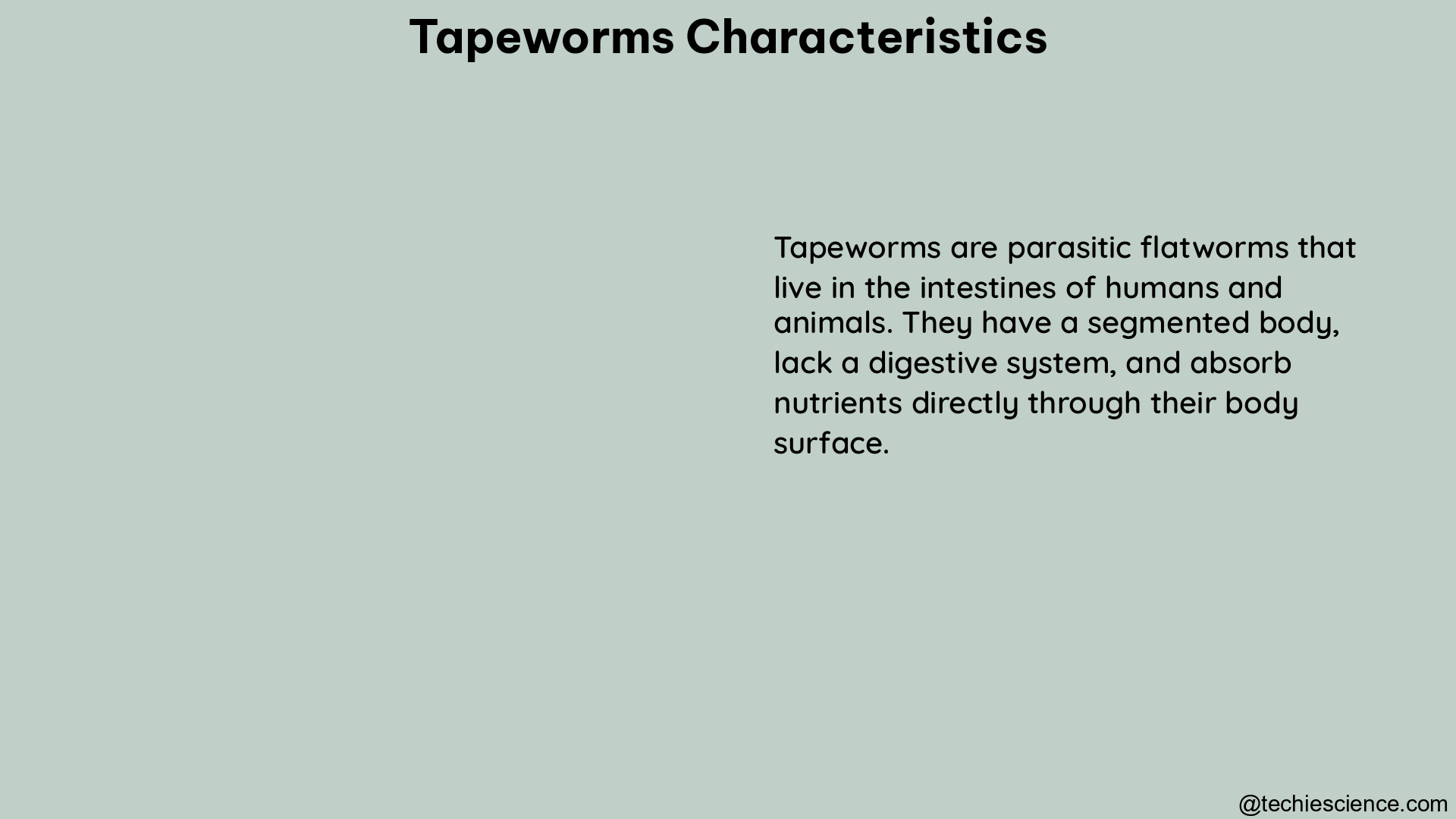Tapeworms, scientifically known as Cestoda, are a group of parasitic flatworms characterized by their long, flat, and segmented bodies. These unique organisms have evolved a range of fascinating biological characteristics that enable them to thrive as successful parasites in their host environments.
Segmented Body Structure
Tapeworms are known for their distinctive segmented body structure, which is a key feature that sets them apart from other types of flatworms. Each segment, or proglottid, contains both male and female reproductive organs, allowing for efficient self-fertilization and the production of large numbers of eggs. The number of proglottids can vary widely among different tapeworm species, with some species having as few as 3-4 proglottids, while others can have hundreds or even thousands of segments.
The proglottids are arranged in a linear fashion, with the oldest segments located at the posterior end of the worm and the youngest segments near the scolex (the attachment organ at the anterior end). As the tapeworm matures, the older proglottids detach and are expelled from the host, carrying with them a large number of fertilized eggs that can infect new hosts.
Scolex and Attachment Mechanisms

The scolex, or head, of a tapeworm is the primary attachment organ that allows the parasite to firmly anchor itself to the intestinal wall of its host. Tapeworms possess a variety of specialized structures on their scolex, such as suckers, bothridia, or hooks, which they use to latch onto the host’s intestinal lining.
The scolex of different tapeworm species can vary significantly in shape and size, reflecting the diverse evolutionary adaptations of these parasites. For example, the scolex of the pork tapeworm (Taenia solium) has four muscular suckers, while the beef tapeworm (Taenia saginata) has a scolex with two rows of hooks in addition to the suckers.
These attachment mechanisms not only secure the tapeworm’s position within the host’s intestine but also help to prevent the parasite from being expelled during the host’s digestive processes or peristaltic movements.
Lack of Digestive and Circulatory Systems
Tapeworms are unique among parasitic flatworms in that they lack a true digestive system and circulatory system. Instead, they rely on the diffusion of nutrients and gases through their body surface, a process known as ectosymbiosis.
The absence of a digestive tract means that tapeworms must absorb all of their nutrients directly from the host’s intestinal contents, including carbohydrates, proteins, and lipids. This adaptation allows the tapeworm to conserve energy and resources that would otherwise be used to maintain a complex digestive system.
Similarly, the lack of a circulatory system means that tapeworms must rely on the diffusion of oxygen and other gases through their body surface to meet their metabolic needs. This process is facilitated by the tapeworm’s flat, ribbon-like body shape, which provides a large surface area-to-volume ratio for efficient gas exchange.
Excretory and Secretory Systems
Tapeworms possess a specialized excretory system that helps to remove waste products and maintain homeostasis within their bodies. This system consists of a network of flame cells and excretory tubules that collect and expel metabolic waste, such as ammonia and urea, through pores in the tapeworm’s body wall.
In addition to their excretory system, tapeworms also have a secretory system that produces a variety of bioactive molecules, known as excretory/secretory products (ESPs). These ESPs play a crucial role in the tapeworm’s ability to modulate the host’s immune response and create a favorable environment for the parasite’s survival.
One study identified a total of 49 metabolites in the ESPs of the tapeworm Dipylidium caninum, including 35 known polar metabolites and 14 fatty acids. Of these, 12 were found to have known pharmacological properties, notably as anti-inflammatory agents. These bioactive molecules may contribute to the immune dampening effects of tapeworms in their definitive mammalian hosts, allowing them to thrive in the hostile environment of the gut.
Reproductive Strategies
Tapeworms have evolved a highly efficient reproductive strategy that allows them to produce large numbers of offspring and increase their chances of infecting new hosts. As mentioned earlier, each proglottid of a tapeworm contains both male and female reproductive organs, enabling self-fertilization and the production of thousands of eggs.
The eggs are released from the tapeworm’s body as the older proglottids detach and are expelled from the host. These eggs can then be ingested by an intermediate host, where they hatch and develop into a larval stage known as a cysticercus or hydatid cyst. When the intermediate host is consumed by the definitive host (the host in which the adult tapeworm lives), the larval stage develops into the adult tapeworm, completing the life cycle.
The ability of tapeworms to produce such large numbers of eggs is a key factor in their success as parasites. For example, a single adult Taenia saginata (beef tapeworm) can produce up to 100,000 eggs per day, which can be released into the environment and potentially infect new hosts.
Genetic Characteristics
Tapeworms have a unique karyotype, with a haploid number of chromosomes ranging from 2 to 20, depending on the species. This karyotype is highly conserved within tapeworm species, making it a useful tool for taxonomic and phylogenetic studies.
The genetic diversity of tapeworms can also be studied using molecular techniques, such as DNA sequencing and analysis of mitochondrial DNA. These methods have revealed the complex evolutionary relationships and phylogenetic history of different tapeworm species, as well as their adaptations to various host environments.
Aggregation and Host Interactions
Tapeworms are known for their ability to aggregate within their host’s intestine, a phenomenon that can be measured using various methods. One study used principal component analysis (PCA) to show clear separation of D. caninum secreted metabolites from culture media components, indicating that tapeworms secrete unique metabolites that can be used as a measure of aggregation.
The aggregation of tapeworms in their hosts is thought to be an adaptive strategy that enhances their reproductive success and survival. By clustering together, tapeworms can more effectively compete for resources, such as nutrients and attachment sites, and coordinate their reproductive activities to maximize the production and dispersal of eggs.
Moreover, the interactions between tapeworms and their hosts are complex and multifaceted. Tapeworms have evolved a range of strategies to manipulate the host’s immune system and create a favorable environment for their own survival. This includes the production of immunomodulatory ESPs, as well as the ability to induce changes in the host’s behavior and physiology.
Conclusion
Tapeworms are fascinating parasitic organisms that have evolved a remarkable array of biological characteristics to thrive in their host environments. From their segmented body structure and specialized attachment mechanisms to their unique excretory and reproductive strategies, tapeworms demonstrate the remarkable adaptability and complexity of parasitic flatworms.
By understanding the detailed characteristics of tapeworms, researchers and clinicians can better develop effective strategies for the prevention, diagnosis, and treatment of tapeworm infections, which continue to be a significant public health concern in many parts of the world.
References:
- Phurpa Wangchuk, Constantin Constantinoiu, Ramon M. Eichenberger, Matt Field, and Alex Loukas. Characterization of Tapeworm Metabolites and Their Reported Biological Activities. Frontiers in Cellular and Infection Microbiology, 2019.
- Parasitology: cestodes general characteristics (tapeworms). Quizlet, 2021.
- Three methods to measure parasite aggregation using examples. Journal of Animal Ecology, 2021.
- Tapeworm – an overview. ScienceDirect, 2022.
- Tapeworms – an overview. ScienceDirect, 2022.

Hello, I am Bhairavi Rathod, I have completed my Master’s in Biotechnology and qualified ICAR NET 2021 in Agricultural Biotechnology. My area of specialization is Integrated Biotechnology. I have the experience to teach and write very complex things in a simple way for learners.